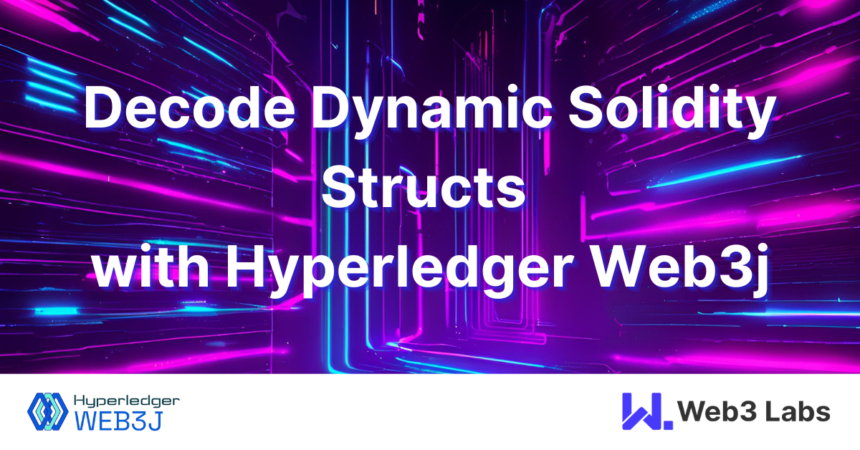In Solidity, dynamic structs represent sophisticated data types that can accommodate various elements of different sizes, including arrays, mappings, or other structs. The blockchain encodes these dynamic structs into binary format in accordance with Ethereum’s ABI (Application Binary Interface) encoding specifications. This encoding occurs whenever the structs are stored or transmitted via transactions.
Properly decoding this binary information is essential for understanding the state or output of a smart contract. This decoding process entails grasping how Solidity organizes and packs the data, especially in dynamic types, to faithfully recreate the original struct from its binary form. This knowledge is vital for constructing robust and compatible decentralized applications.
Decoding dynamic structs within an external development environment that interacts with a blockchain can be quite complex. These structs might comprise arrays, mappings, and nested structs of varying sizes, requiring meticulous management to ensure data integrity during both encoding and decoding processes. In Hyperledger Web3j, we tackled this issue by creating object classes that align with the anticipated struct format in the blockchain context.
These object classes are engineered to extend the org.web3j.abi.datatypes.DynamicStruct class, which belongs to the ABI module. This class is specifically developed to navigate the intricacies of encoding and decoding dynamic structs, along with other Solidity data types. The ABI module takes advantage of Hyperledger Web3j’s type-safe mappings for straightforward and secure interactions with these intricate data structures.
Yet, when aiming to extract a specific value from encoded data, the creation of a dedicated object may introduce unnecessary complications. This method can also consume additional resources. To overcome this, our contributors, calmacfadden and Antlion12, implemented significant improvements by building upon the org.web3j.abi.TypeReference class.
Their modifications facilitate dynamic decoding directly within the class, eliminating the necessity to create superfluous objects. This improvement streamlines the process of extracting specific values from encoded data. This progress minimizes overhead and enhances the usability of blockchain data interactions.
Decoding Dynamic Struct Before Enhancements
To illustrate, here’s a code snippet demonstrating how to decode dynamic structs using Hyperledger Web3j prior to the enhancements.
/**
* Create the Java object representing the Solidity dynamic struct
* struct User{
* uint256 user_id;
* string name;
* }
*/
public static class User extends DynamicStruct {
public BigInteger userId;
public String name;
public Boz(BigInteger userId, String name) {
super(
new org.web3j.abi.datatypes.generated.Uint256(data),
new org.web3j.abi.datatypes.Utf8String(name));
this.userId = userId;
this.name = name;
}
public Boz(Uint256 userId, Utf8String name) {
super(userId, name);
this.userId = userId.getValue();
this.name = name.getValue();
}
}
/**
* Create the function that should be able to handle the above class
* as a Solidity struct equivalent
*/
public static final org.web3j.abi.datatypes.Function getUserFunction = new org.web3j.abi.datatypes.Function(
FUNC_SETUSER,
Collections.emptyList(),
Arrays.asList(new TypeReference() {}));
Now that the prerequisites are established, the only remaining task is to execute the decode, illustrated in the example below:
@Test
public void testDecodeDynamicStruct2() {
String rawInput =
"0x0000000000000000000000000000000000000000000000000000000000000020"
+ "000000000000000000000000000000000000000000000000000000000000000a"
+ "0000000000000000000000000000000000000000000000000000000000000040"
+ "0000000000000000000000000000000000000000000000000000000000000004"
+ "4a686f6e00000000000000000000000000000000000000000000000000000000
";
assertEquals(
FunctionReturnDecoder.decode(
rawInput,
getUserFunction.getOutputParameters()),
Collections.singletonList(new User(BigInteger.TEN, "John")));
}
In the test above, we decoded and verified that the rawInput corresponds to a User struct with the name John and userId 10.
Decoding Dynamic Struct With New Enhancements
With the newly implemented approach, declaring an equivalent struct object class is now unnecessary. When the method receives the encoded data, it can directly decode it by creating an appropriate reference type. This streamlines the workflow and diminishes the need for extra class definitions. Below is an example of how this can be achieved:
public void testDecodeDynamicStruct2() {
String rawInput =
"0x0000000000000000000000000000000000000000000000000000000000000020"
+ "000000000000000000000000000000000000000000000000000000000000000a"
+ "0000000000000000000000000000000000000000000000000000000000000040"
+ "0000000000000000000000000000000000000000000000000000000000000004"
+ "4a686f6e00000000000000000000000000000000000000000000000000000000
";
TypeReference dynamicStruct =
new TypeReference(
false,
Arrays.asList(
TypeReference.makeTypeReference("uint256"),
TypeReference.makeTypeReference("string"))) {};
List decodedData =
FunctionReturnDecoder.decode(rawInput,
Utils.convert(Arrays.asList(dynamicStruct)));
List decodedDynamicStruct =
((DynamicStruct) decodedData.get(0)).getValue();
assertEquals(decodedDynamicStruct.get(0).getValue(), BigInteger.TEN);
assertEquals(decodedDynamicStruct.get(1).getValue(), "John");}
In conclusion, Hyperledger Web3j has achieved significant advancements in simplifying the decoding of dynamic Solidity structs. This addresses one of the more taxing aspects of blockchain development. By introducing object classes such as org.web3j.abi.datatypes.DynamicStruct and enhancing the org.web3j.abi.TypeReference class, the framework now offers a more effective and streamlined approach for managing these intricate data types.
Developers are no longer required to create dedicated struct classes for each interaction, which minimizes complexity and resource usage. These advancements do not only enhance the efficiency of blockchain applications but also simplify the development process, reducing the likelihood of errors. Ultimately, this contributes to the creation of more reliable and interoperable decentralized systems.








